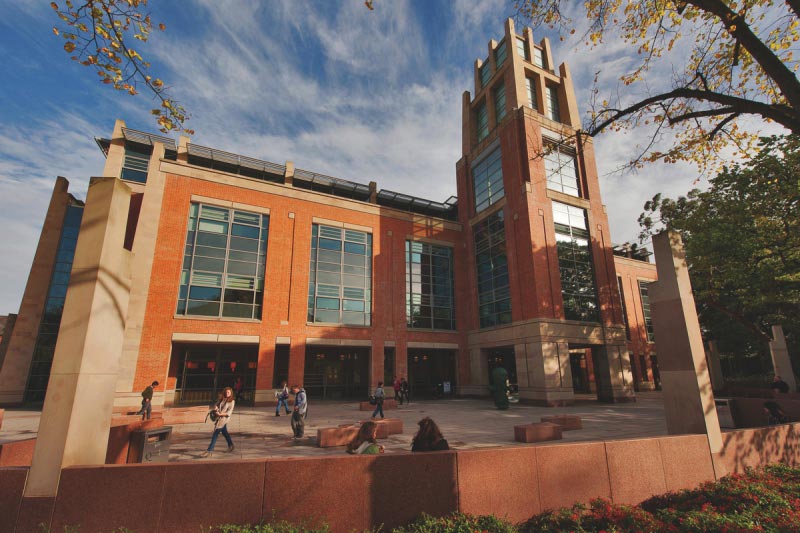This is what the Image and Text Expander content type looks like. This example shows two items from our Web Support Team Newsletter, each using Image and Text Expander:
The Image and Text Expander displays a single content item, with text on the right and an image on the left.
You can add this content type to any page within your site. It can be used on its own on a webpage, along with other content types. For example, your webpage could be built using the following blocks of content: a One Horizontal with Background; then a General Content; then an Image and Text Expander and then another General Content.
More commonly, this content type is used a number of times on the same page to create a stacked list of information items. A good example of this is the Queen's Staff Roundup. You have the option to include a short paragraph of text and then a longer additional paragraph, which is displayed by clicking the Read More link.
The image dimensions for this content type are 800*533 pixels
General Guidance
Please use the following information to help ensure that you are using this content type correctly:
- Some of the fields have character limits as defined in the form field guidance below. Please ensure you are aware of these before planning out content using this content type.
Imagery
- You should have full permission for any image you intend to use on your website.
- All images should be the correct dimensions, 800 x 533 pixels (width x height) and optimised for the web. For users that do not have access to Adobe Photoshop or a similar image editing resource, we would recommend the use of PIXLR, a free online image editing platform. This platform can be used to resize and optimise images.
- You must use the correct naming convention for image filenames, as follows:
- Use only lowercase letters (a to z), numerals (0-9) and hyphens (-);
- Do not use spaces. Instead, use hyphens to separate words.
- Do not use special characters (e.g., £, %, &, á) or underscores.
- The following resource explains how to optimise an image for use on the web.
- You are not required to add an Image Alt Text / Description if the image will be decorative only. Further information is available in the Text Alternatives for Images section of our Accessible Content Guidance.
- Do not create images with embedded text. The image will be inaccessible and the text will not scale across mobile and desktop devices. If an image with text is required, please use an alternative content type to display this information, such as DTP - One Horizontal.
Links
- To link to a specific section on your website use a Section Link. The CMS automatically remembers section links, even if you need to move the linked section when restructuring or reorganising content on your website.
- To link to a specific piece of content on your website, use a Content Link. As with section links, the CMS will automatically remember the content link, even if the content is moved to another location on your website.
- When linking to an external website or resource, then use a Web Address. The full URL of the website or resource is required i.e. https://www.qub.ac.uk. Please note that the majority of websites published via the CMS are now accessed over HTTPS only.
Accessibility Guidance
Please use the following guidance to help make sure your content adheres to accessibility regulations:
- Do not add HTML elements such as
span,div,h1or otherwise to any of the form elements to change the structure of the content type. Either you will be asked to remove it, or it will be removed by the Web Support Team. - Do not add any CSS styling or selectors to any of the form elements to change the display of the content added to the content type. Either you will be asked to remove it, or it will be removed by the Web Support Team.
- Do not create images with embedded text.
- Do not add image Alt Text / Description to your image if it is decorative. Further information is available in the Text Alternatives for Images section of our Accessible Content Guidance.
- Do make sure that the link text used is as descriptive as possible. Do not use generic link text such as 'Click Here' and 'Read More'. Further information and examples are available in the Using Links Effectively section of our Accessible Content Guidance.
Form Field Guidance
Please use the following information to help you use this Content Type effectively:
| Field Title | Information | Is it required? |
|---|---|---|
| Name | This is the name of the content block, only visible to editors of the section. | Yes |
| Heading | Add a heading. Maximum characters allowed: 55 |
Yes |
| Title | Add a title. This is located directly underneath the heading. It is usually longer than the heading. Maximum characters allowed: 130 |
Yes |
| Summary | Used either as an emphasised introduction to the content located below in the Main Text field OR used as the text of the item itself (if you are not adding any content to the Main Text field). Maximum characters allowed: 1500 |
No |
| Main Text | Used for the main body of text located below the Summary and viewed by clicking 'Read More'. Maximum characters allowed: 6000 |
No |
| Image | Add your optimised image via the Media Library. Maximum image dimensions are 800 x 533 pixels. | No |

